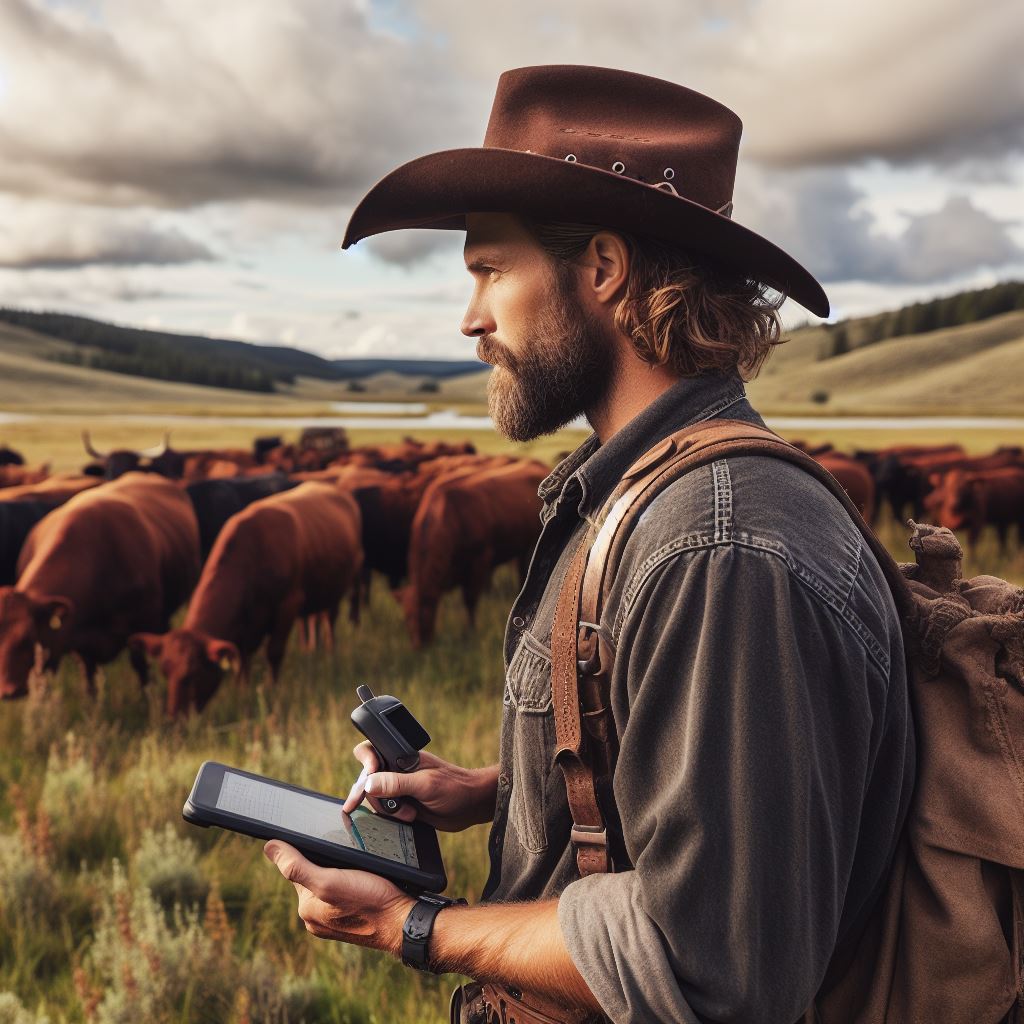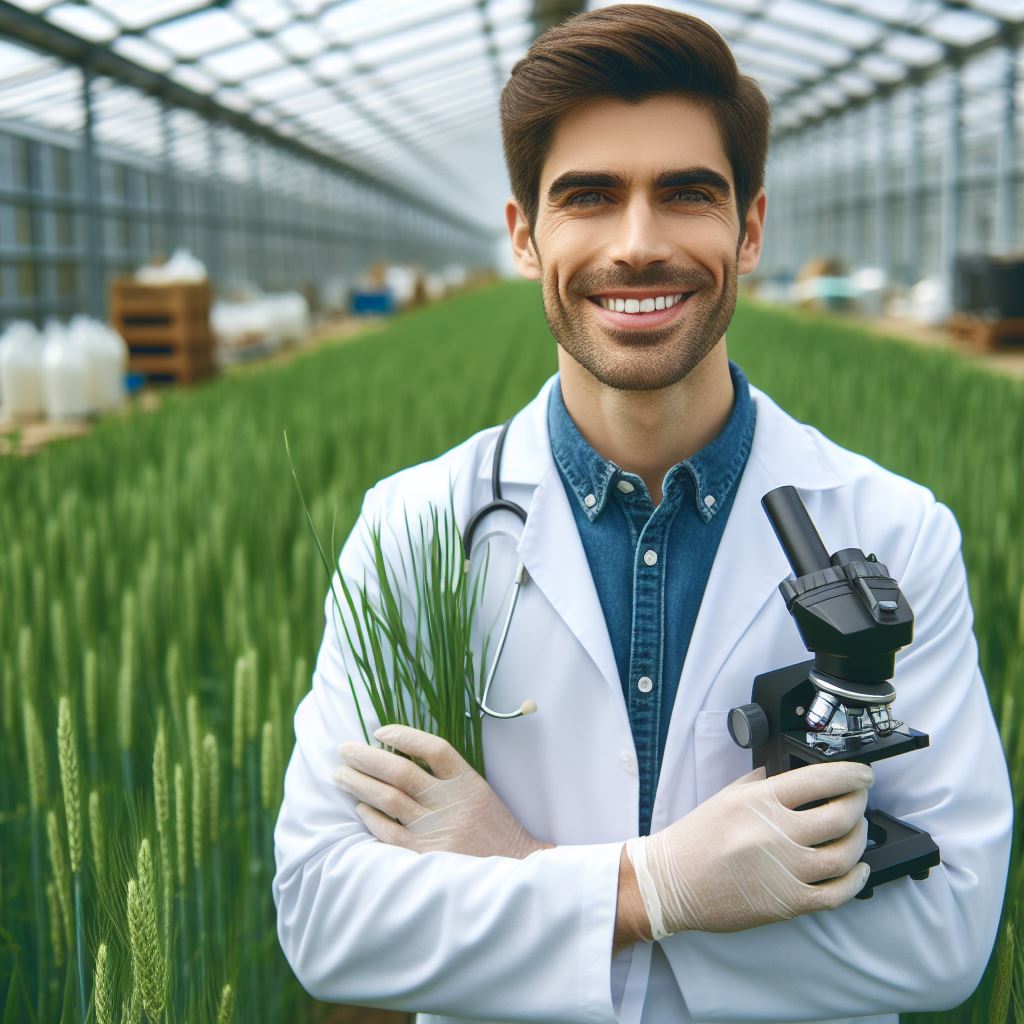Introduction
In the world of livestock farming, managing the health of cattle is crucial for farmers’ success. With the advancement of technology, a new concept called e-health for cattle has emerged.
This involves the use of digital monitoring devices to track and analyze various health parameters of the animals.
E-health for cattle is significant as it allows farmers to detect early signs of illness or distress, enabling timely intervention and prevention of potential diseases.
These advancements have revolutionized the way farmers manage their livestock, leading to improved animal welfare and productivity.
One major aspect of e-health for cattle is the implementation of wearable devices. These devices are designed to monitor vital signs such as body temperature, heart rate, and respiratory rate.
They transmit real-time data to a central system, allowing farmers to remotely monitor the health of their animals and detect any abnormalities.
Another important component of e-health for cattle is the utilization of data analytics. The collected data from wearable devices can be analyzed using advanced algorithms to identify patterns, correlations, and anomalies.
This helps farmers make informed decisions regarding the health and well-being of their cattle.
Moreover, e-health for cattle has brought about the concept of precision farming. This involves the integration of various technologies, such as sensors, GPS, and artificial intelligence, to optimize the management of livestock.
By precisely monitoring the health and behavior of individual animals, farmers can provide personalized care, enhance breeding programs, and improve overall herd performance.
In fact, e-health for cattle, driven by technological advancements, has revolutionized livestock farming.
It offers farmers the ability to remotely monitor the health of their cattle, detect early signs of illness, and make informed decisions for improved animal welfare and productivity.
With further advancements, the future of e-health for cattle looks promising, providing even greater benefits to the industry.
Traditional methods of cattle health monitoring and management
Manual health checks
Cattle health monitoring traditionally involves regular manual checks by farmers or farm workers. During these checks, farmers physically examine each animal for signs of illness or injury.
This method requires proximity to the cattle and can be time-consuming, especially for larger herds. Manual checks are also subjective and rely on the farmer’s ability to accurately identify health issues.
Transform Your Agribusiness
Unlock your farm's potential with expert advice tailored to your needs. Get actionable steps that drive real results.
Get StartedIt is challenging to detect early symptoms of diseases or underlying health problems through manual checks alone.
Moreover, manual checks may not provide comprehensive data about the overall health of the cattle.
Veterinarian visits
Another traditional method of cattle health management is periodic visits by veterinarians.
- Veterinarians conduct thorough examinations, including physical inspections, blood tests, and vaccinations.
- These visits ensure that any health issues are diagnosed and treated by professionals.
- However, veterinary visits can be costly, especially when frequent check-ups are required for large herds.
- Additionally, scheduling appointments and waiting for veterinarians can lead to prolonged response times.
- This can be problematic when immediate diagnosis and treatment are necessary to prevent disease outbreaks.
Challenges and limitations of traditional methods
- Traditional methods of cattle health monitoring and management have several challenges and limitations.
- Both manual health checks and veterinarian visits are labor-intensive and time-consuming.
- The subjectivity of manual checks and the cost of veterinary visits pose financial burdens on farmers.
- These methods also rely on human expertise and may not provide comprehensive and objective data.
- It is difficult to detect early warning signs and potential health issues without advanced technology.
- Furthermore, traditional methods may not be effective in preventing large-scale disease outbreaks.
Overall, traditional methods of cattle health monitoring and management have their limitations. They require significant time, effort, and financial resources.
Moreover, these methods may not provide comprehensive data or timely interventions.
The advancements in e-health technologies offer promising solutions to overcome these challenges and revolutionize cattle health management.
Read: Irrigation Tech: Saving Water in Farming
Overview of tech advancements in e-health for cattle
E-health for cattle has seen significant advancements in recent years, revolutionizing the way farmers and veterinarians monitor and manage the health of their livestock.
These advancements primarily focus on remote monitoring devices, implantable microchips, and data analytics.
Remote monitoring devices
Remote monitoring devices have become increasingly popular, providing real-time data on the vital signs and activity levels of cattle.
Wearables such as smart collars equipped with sensors can track heart rate, body temperature, and respiratory rates.
This allows farmers to detect any abnormal changes in the cattle’s health and take necessary action promptly.
The ability to remotely monitor and collect data without manual intervention has greatly improved the efficiency and accuracy of health tracking.
Implantable microchips for identification and health monitoring
Implantable microchips offer a more permanent solution for identification and health monitoring. These tiny chips can be inserted under the skin of the cattle and provide a unique identification code.
Additionally, they can collect and transmit data about the animal’s vitals, such as temperature, heart rate, and even rumination patterns.
Veterinarians can access this information with handheld readers, making it easier to assess the overall health and well-being of the cattle without physical contact.
Implantable microchips not only aid in monitoring individual animals but also contribute to efficient record-keeping and management of large herds.
Data analytics and cloud-based platforms for data storage and analysis
- Data analytics and cloud-based platforms play a crucial role in the effective utilization of the collected data.
- By employing sophisticated algorithms, these platforms analyze the data to identify patterns, detect anomalies, and provide actionable insights.
- Farmers can leverage these insights to make informed decisions regarding the health management of their cattle.
- Moreover, secure cloud storage enables remote access from any device, simplifying data management and collaboration with veterinarians and stakeholders.
- Cloud data analysis allows for long-term monitoring and accurate predictions in cattle diseases and herd management.
Overall, the advancements in e-health for cattle have revolutionized the livestock industry.
Remote monitoring devices, implantable microchips, and data analytics have streamlined health tracking, improved disease management, and optimized farm operations.
The ability to monitor vital signs, identify cattle, and analyze data in real-time has proven to be invaluable for farmers and veterinarians in ensuring the well-being and productivity of their cattle.
As technology continues to advance, we can expect further enhancements in e-health for cattle, leading to more sustainable and efficient livestock management practices.
Read: Climate-Smart Agriculture: Tools & Techniques
Benefits of Tech Advancements in E-Health for Cattle
Enhanced Health Monitoring and Early Detection of Illnesses
With the help of technology, e-health systems for cattle have greatly improved health monitoring capabilities. Sensors and wearable devices can continuously track vital signs and detect abnormalities.
This constant monitoring allows for the early detection of illnesses, enabling farmers to take prompt action and prevent the spread of diseases within their herds.
Showcase Your Farming Business
Publish your professional farming services profile on our blog for a one-time fee of $200 and reach a dedicated audience of farmers and agribusiness owners.
Publish Your ProfileImproved Disease Management and Prevention
Technological advancements have revolutionized disease management and prevention in the cattle industry.
Data collected from e-health systems provide crucial insights into the overall health of individual animals and their susceptibility to specific diseases.
This information enables farmers to implement targeted vaccination programs, develop effective treatment plans, and reduce the risk of disease outbreaks.
Increased Efficiency and Reduced Labor Costs
E-health solutions streamline various tasks and reduce the need for manual labor, resulting in increased efficiency and reduced costs for cattle farmers.
Automated systems can collect and analyze data, reducing the time and effort required in traditional health monitoring methods.
Farmers can remotely access information about their cattle’s health, minimizing the need for frequent physical check-ups and saving valuable time and resources.
By automating certain processes, farmers can allocate their workforce more effectively, concentrating on other essential aspects of cattle management.
Enhanced Decision-Making Based on Data-Driven Insights
- Thanks to technology, e-health systems generate vast amounts of data, providing farmers with valuable insights for decision-making.
- Analytics tools can interpret this data, highlighting trends and patterns that may be difficult to observe with manual monitoring alone.
- By leveraging data-driven insights, farmers can make informed decisions about breeding, nutrition, and overall herd management, optimizing productivity and profitability.
- Furthermore, digital records maintained by these systems allow for easy tracking of individual animal health histories, simplifying the decision-making process.
In short, the benefits of tech advancements in e-health for cattle are extensive and transformative.
Improved health monitoring, early illness detection, disease management, efficiency, reduced labor costs, and data-driven decision-making revolutionize the cattle industry.
By embracing these advancements, farmers can ensure better health outcomes for their cattle and enhance their overall farming practices.
Read: Vertical Farming: Tech Meets Tradition
Case studies or examples of successful tech implementations in e-health for cattle
Strafford Dairy Farm’s wearable device and its impact on cattle health
Strafford Dairy Farm, a leading cattle farm in the region, implemented a cutting-edge wearable device for their cattle.
The device uses sensors to monitor various health parameters, including body temperature, heart rate, and activity levels. The results have been remarkable.
The wearable device has enabled the farm to closely monitor the health of each animal, ensuring early detection of any potential health issues.
By receiving real-time data, the farm can promptly intervene and provide necessary medical treatment, significantly reducing the likelihood of severe illnesses or fatalities.
The impact of the wearable device on the overall health of the cattle has been tremendous.
By closely monitoring their vital signs, the farm has been able to maximize the well-being of their animals and ultimately improve their productivity.
Research study on the effectiveness of implantable microchips in disease prevention
A recent research study conducted by a team of veterinary experts focused on analyzing the effectiveness of implantable microchips in preventing diseases among cattle.
The study involved several farms across the country, each implementing the microchip technology in their herds.
The results of the study were highly promising. The microchips allowed for continuous tracking of the cattle’s health status, including their vaccination history and any potential diseases they may have been exposed to.
This information was then analyzed by veterinary professionals to develop targeted prevention strategies.
The implementation of implantable microchips significantly reduced the incidence of serious diseases among cattle.
By identifying and isolating infected animals promptly, the spread of diseases within the herds was effectively controlled. This technology proved to be a game-changer in disease prevention and herd management.
Success story of a farm using data analytics to optimize cattle management
- In the era of data-driven decision-making, one successful farm embraced advanced data analytics to optimize its cattle management practices.
- They implemented a comprehensive system that collects various data points related to their cattle, including feeding patterns, weight gain, and behavior.
- State-of-the-art data analysis techniques allowed the farm to extract valuable insights from this vast amount of data.
- By identifying patterns and correlations, the farm was able to adjust their feeding schedules, improve nutrition plans, and optimize their cattle’s growth potential.
- The farm’s success story is a testament to the transformative power of data analytics.
- By utilizing the collected data effectively, they achieved higher productivity, reduced costs, and improved overall herd health.
These case studies highlight the transformative impact of technology in the field of e-health for cattle.
The implementation of wearable devices, implantable microchips, and data analytics has revolutionized the way cattle farms approach healthcare and management.
As technology continues to advance, we can expect even more innovative solutions to emerge, further improving the well-being and productivity of our precious livestock.

Challenges and Considerations in Implementing Tech Advancements in E-Health for Cattle
Cost of technology and infrastructure
- The implementation of advanced e-health technologies for cattle requires significant financial investment.
- Farmers and ranchers need to invest in sensors, wearable devices, and other monitoring technologies.
- There is also a need to establish a robust infrastructure for data storage and transmission.
- The cost of initial setup and ongoing maintenance can be a barrier for some farmers.
- Government support and subsidies can help alleviate the financial burden.
Training and adoption by farmers and ranchers
- Many farmers may lack the necessary technical skills to operate and interpret e-health technologies.
- Training programs should be developed to educate farmers on the benefits and usage of these technologies.
- Efforts should be made to promote awareness among farmers about the potential advantages of e-health for cattle.
- Providing user-friendly interfaces and clear instructions can facilitate adoption and ease the learning curve.
- Farmer organizations and agricultural institutions can play a crucial role in promoting training and adoption.
Data privacy and security concerns
- The collection and storage of sensitive cattle health data raise privacy and security concerns.
- Unauthorized access to this data can lead to misuse or exploitation.
- Farmers may be reluctant to share data if they are not assured of its confidentiality.
- Rigorous data encryption and secure server infrastructure are vital to protecting sensitive information.
- Regulations should be established to ensure data privacy and guidelines for responsible data usage.
Despite these challenges, the advancements in e-health for cattle hold great promise. By addressing the cost, training, and security concerns, the benefits are undeniable.
Improved animal welfare, more efficient health monitoring, and better disease management are just a few advantages of embracing these tech advancements.
The collaboration between technology developers, governmental bodies, farmer organizations, and agricultural institutions is crucial to ensuring a successful implementation.
By working together, we can overcome these challenges and unlock the full potential of e-health for cattle.
Future Prospects and Emerging Trends in e-health for Cattle
Artificial intelligence and machine learning applications
- Artificial intelligence (AI) and machine learning (ML) are revolutionizing the e-health sector for cattle.
- Through AI and ML algorithms, veterinarians can interpret large amounts of data to detect health issues.
- These technologies can predict disease outbreaks, identify patterns, and provide timely interventions.
- With AI and ML, farmers can improve decision-making, optimizing cattle health and production.
- AI-powered devices can track vital signs, and behavior, and analyze real-time data to ensure early detection.
- Disease diagnosis can be more accurate, reducing errors and unnecessary treatment costs.
- AI and ML applications can significantly enhance disease prevention and early detection in cattle.
- These advancements have the potential to save farmers time, money, and resources in the long run.
Integration of e-health with precision agriculture
- E-health for cattle can be seamlessly integrated with precision agriculture for improved livestock management.
- Precision agriculture utilizes GPS, sensors, and data analytics to optimize farming practices.
- Integration with e-health allows farmers to monitor cattle health in real-time and make informed decisions.
- Data collected through e-health systems can be analyzed to adjust feed, medication, and breeding strategies.
- Precision agriculture helps improve efficiency, reduce waste, and increase overall productivity.
- These technologies enable farmers to implement targeted interventions, enhancing cattle welfare and performance.
- By combining e-health and precision agriculture, farmers can achieve sustainable and profitable livestock farming.
- Integration can also enhance traceability, allowing consumers to have more confidence in the food supply chain.
Potential advancements in remote monitoring devices
- The future of e-health for cattle lies in the development of advanced remote monitoring devices.
- These devices will offer real-time monitoring of cattle health, even in remote locations.
- Wireless sensors will collect data on vital signs, rumination, activity level, and other relevant parameters.
- Advanced algorithms will analyze the data, providing valuable insights to farmers and veterinarians.
- Remote monitoring devices will enable early detection of diseases and prompt intervention.
- They will also provide alerts for unusual behaviors or health deviations, ensuring timely action.
- Artificial intelligence will further enhance the accuracy of remote monitoring devices.
- With continuous advancements, these devices will become smaller, lighter, and more affordable.
In essence, the promising future of cattle e-health involves integrating AI, machine learning, combining it with precision agriculture, and developing advanced remote monitoring devices.
These emerging trends have the potential to revolutionize the livestock industry by improving disease prevention, optimizing farming practices, and enhancing cattle welfare.
Farmers can benefit from real-time data analysis, accurate disease diagnosis, and targeted interventions, leading to increased productivity and profitability.
The integration of e-health with precision agriculture will also boost traceability and consumer trust in the food supply chain.
As remote monitoring devices continue to evolve, farmers will have access to real-time and accurate information, enabling early detection and prompt action.
Overall, these advancements in e-health for cattle hold great promise for the future.
Read: Tech Trends: AI & Crop Management
Conclusion
The rapid advancements in technology have opened up new possibilities in the field of e-health for cattle.
These advancements have the potential to revolutionize the way cattle are monitored and treated, leading to improved animal welfare and increased efficiency in the industry.
By embracing these technologies, farmers and ranchers can benefit from real-time data and analytics, enabling them to make more informed decisions when it comes to the health and well-being of their cattle.
Showcase Your Farming Business
Publish your professional farming services profile on our blog for a one-time fee of $200 and reach a dedicated audience of farmers and agribusiness owners.
Publish Your ProfileFrom remote monitoring and wearable devices to data-driven diagnostics and telemedicine, the future of e-health in the cattle industry looks promising.
Farmers and ranchers must explore and invest in these technologies.
By doing so, they can optimize their operations, prevent disease outbreaks, and minimize the use of antibiotics and other medications.
These technologies also have the potential to reduce labor and veterinary costs.
While there may be initial barriers to adoption, such as cost and training, the long-term benefits are clear.
E-health has the potential to not only improve the overall health and productivity of cattle but also enhance sustainability in the industry.
In cloising, e-health for cattle holds great promise. It is an opportunity for farmers and ranchers to leverage technology for the betterment of their herds, their businesses, and the industry as a whole.
Embracing these advancements is the key to unlocking the potential benefits and ensuring a thriving and sustainable future for the cattle industry.




